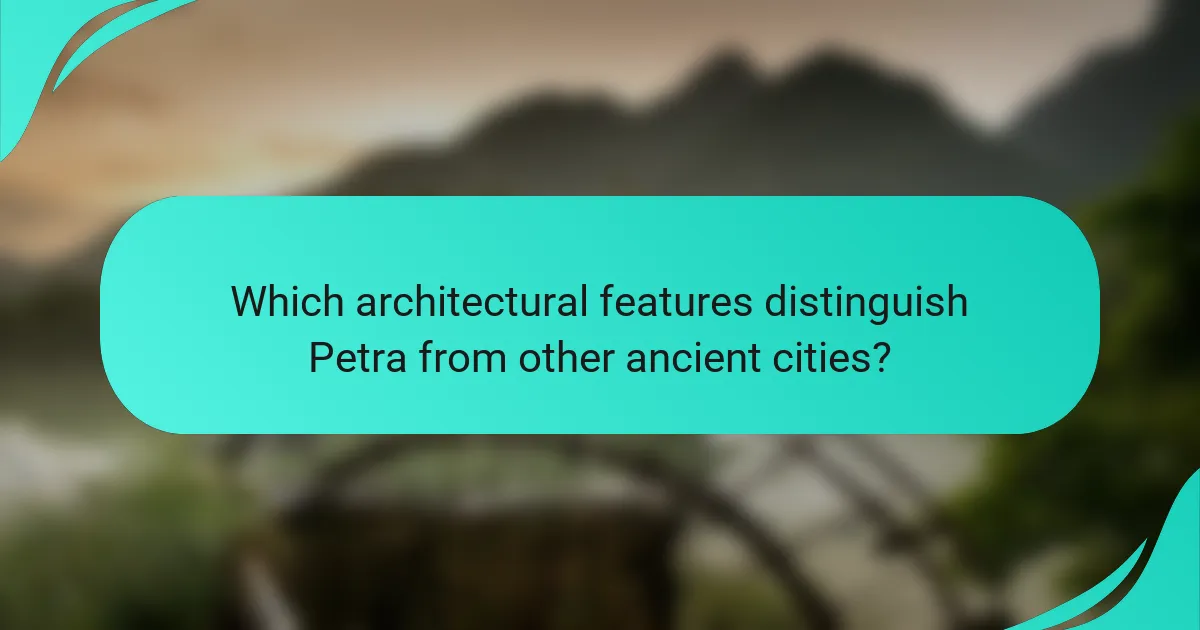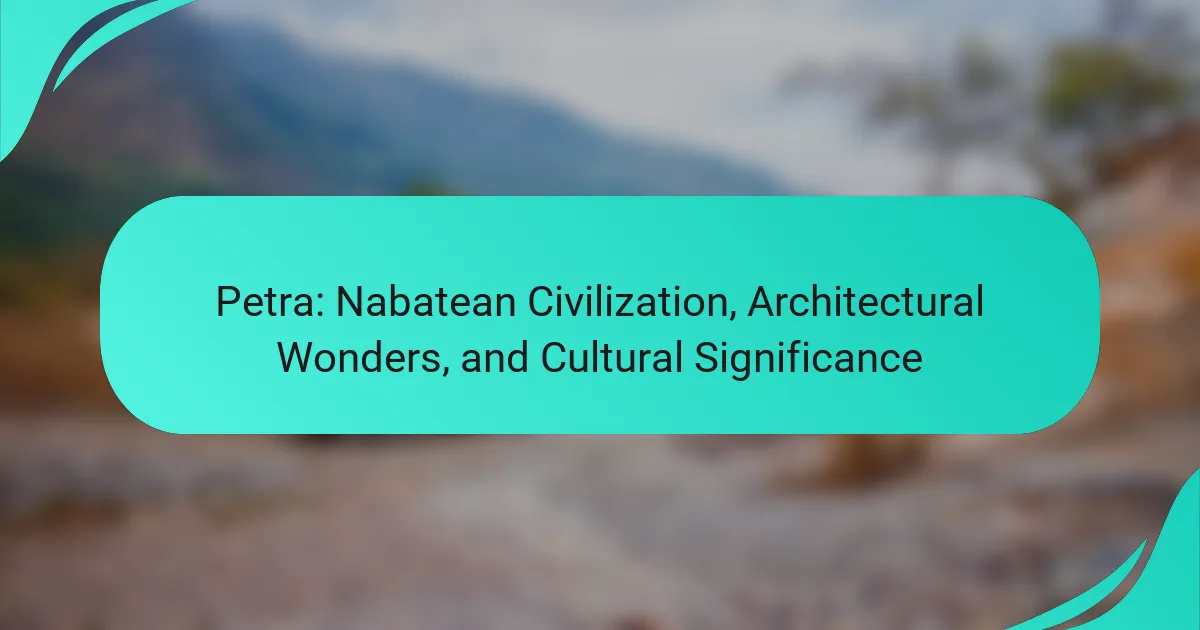Petra, a UNESCO World Heritage Site, showcases the architectural brilliance of the Nabatean civilization. This article explores its rock-cut structures, advanced water management systems, and cultural significance. Discover the unique blend of Hellenistic and Eastern influences that define Petra’s monumental landmarks. Learn about the challenges facing this historical site and the importance of sustainable preservation efforts.

What are the key characteristics of the Nabatean civilization?
The Nabatean civilization is characterized by advanced architecture, trade networks, and cultural syncretism. They are known for their rock-cut buildings in Petra, sophisticated water management systems, and vibrant trade routes connecting Arabia, Egypt, and the Mediterranean. Unique attributes include their script, Nabatean Arabic, and rare artistic styles blending Hellenistic and Eastern influences. Their contributions to agriculture and commerce significantly impacted regional development.
How did trade influence the development of Petra?
Trade significantly influenced Petra’s development by establishing it as a vital commercial hub. The city’s strategic location on trade routes facilitated the exchange of goods, ideas, and cultures. This interaction led to architectural advancements, blending various styles, and fostering economic prosperity. The Nabateans capitalized on trade by developing innovative water conservation techniques, enabling them to thrive in the arid environment. As a result, Petra became a center of wealth and cultural significance in the ancient world, showcasing the impact of trade on its growth and legacy.
What role did water management play in Petra’s sustainability?
Water management was crucial for Petra’s sustainability, enabling efficient resource use in a challenging desert environment. The Nabateans developed sophisticated systems, including cisterns and aqueducts, to collect and store rainwater. This innovation supported agriculture and daily life, ensuring the city’s resilience. The unique water conservation techniques allowed Petra to thrive, demonstrating the civilization’s advanced engineering and adaptability.

Which architectural features distinguish Petra from other ancient cities?
Petra is distinguished by its rock-cut architecture, intricate water conduit systems, and monumental tombs. These features showcase the Nabatean civilization’s engineering prowess and cultural significance.
The most notable architectural element is Al-Khazneh, or the Treasury, carved directly into sandstone cliffs. Its elaborate facade reflects Hellenistic influences combined with local traditions.
Petra’s advanced water management system included cisterns and aqueducts, essential for survival in the arid environment. This innovation facilitated agriculture and trade, enhancing the city’s prosperity.
Additionally, Petra’s unique blend of Eastern and Western architectural styles sets it apart from other ancient cities. This fusion illustrates the cultural exchange that occurred along trade routes.
How do the rock-cut facades reflect Nabatean artistry?
The rock-cut facades of Petra showcase Nabatean artistry through intricate designs and architectural innovation. These facades reflect a blend of Hellenistic and Eastern influences, characterized by elaborate carvings and detailed ornamentation. The unique attribute of these structures is their seamless integration into the surrounding rock, demonstrating advanced engineering skills. Moreover, the use of local sandstone allowed for both durability and aesthetic appeal, enhancing their cultural significance. The facades served not only as tombs but also as symbols of wealth and power within Nabatean society.
What are the notable structures within Petra and their significance?
Petra features remarkable structures like Al-Khazneh, the Monastery, and the Roman Theatre, each showcasing Nabatean engineering and cultural significance. Al-Khazneh, known as the Treasury, symbolizes wealth and power, while the Monastery represents religious devotion. The Roman Theatre, carved into rock, illustrates the blend of cultures and social life in Petra. These structures highlight the architectural ingenuity and the diverse influences that shaped the Nabatean civilization.

Why is Petra considered a cultural symbol for Jordan?
Petra is considered a cultural symbol for Jordan due to its historical significance and architectural marvels. This ancient city, carved into rose-red cliffs, showcases the ingenuity of the Nabatean civilization. Its elaborate structures, such as the Treasury and Monastery, reflect advanced engineering and artistry. Furthermore, Petra represents a fusion of various cultures, including Hellenistic and Arabian influences, highlighting its role as a vital trade hub. As a UNESCO World Heritage Site, it attracts millions, reinforcing its status as a national emblem of Jordanian heritage.
How does Petra’s UNESCO World Heritage status impact tourism?
Petra’s UNESCO World Heritage status significantly boosts tourism by enhancing its global visibility. This recognition attracts millions of visitors annually, drawn to its historical and architectural marvels. As a result, local economies benefit from increased revenue and job creation. UNESCO status also encourages conservation efforts, ensuring the site’s preservation for future generations. Tourists often engage in cultural experiences, deepening their appreciation for the Nabatean civilization and its legacy.
What cultural festivals celebrate Petra’s heritage?
Cultural festivals celebrating Petra’s heritage include the Petra Archaeological Park Festival, the Petra by Night event, and the Jordan Festival. These festivals showcase Nabatean traditions, architectural wonders, and local arts. The Petra Archaeological Park Festival highlights traditional music, dance, and crafts, emphasizing the site’s historical significance. Petra by Night illuminates the ancient city with candles, creating a magical atmosphere that honors its cultural legacy. The Jordan Festival features performances and exhibitions that reflect the rich heritage of the region, connecting past and present.

How has Petra influenced modern architecture and design?
Petra has significantly influenced modern architecture and design through its unique rock-cut structures and innovative water management systems. The Nabateans employed advanced techniques that prioritize functionality and aesthetics, showcasing the importance of integrating natural elements into built environments.
Architectural features such as intricate facades and monumental tombs have inspired contemporary architects to adopt similar styles, emphasizing the harmony between nature and construction. The use of local materials and sustainable practices evident in Petra’s design resonates with today’s eco-friendly architecture trends.
Moreover, Petra’s cultural significance as a trading hub has led to a fusion of artistic styles, influencing design across various disciplines. This blend of cultural elements is reflected in modern urban design, where multicultural influences shape cityscapes.
Which contemporary structures draw inspiration from Petra’s style?
Contemporary structures that draw inspiration from Petra’s style include the Treasury of Petra and the Al-Khazneh replica in Jordan. Modern interpretations often emphasize rock-cut architecture and intricate facades. Notable examples are the Rose City of Petra-inspired structures in Dubai and the Petra Museum, which reflect Nabatean design principles. These buildings showcase the unique attributes of Petra’s architectural heritage.
What lessons can architects learn from Nabatean engineering?
Architects can learn innovative construction techniques and sustainable practices from Nabatean engineering. The Nabateans excelled in adapting to their arid environment, utilizing water conservation methods and integrating natural rock formations into their designs. Their mastery of rock-cut architecture showcases precision and creativity, emphasizing the importance of local materials. Additionally, their complex water management systems demonstrate effective resource utilization, providing valuable lessons in sustainability and resilience for contemporary architects.

What are the challenges facing Petra in the 21st century?
Petra faces significant challenges in the 21st century, including environmental degradation, tourism management, and preservation of its cultural heritage. Climate change threatens the site’s structural integrity, while increased visitor numbers strain resources. Effective conservation strategies are essential to maintain Petra’s architectural wonders and cultural significance. Additionally, local communities seek sustainable economic opportunities without compromising the site’s integrity.
How does climate change threaten Petra’s preservation?
Climate change significantly threatens Petra’s preservation by increasing erosion, altering rainfall patterns, and intensifying temperature fluctuations. These factors accelerate the deterioration of the ancient rock-cut architecture and fragile archaeological features. As a result, the unique attributes of Petra’s sandstone structures face heightened risks from water damage and temperature-related expansion and contraction. Additionally, the cultural significance of Petra, a UNESCO World Heritage site, is jeopardized as climate impacts could diminish its historical integrity and visitor experience.
What measures are being taken to protect Petra’s archaeological sites?
Various measures are being implemented to protect Petra’s archaeological sites. The Jordanian government collaborates with international organizations to enhance preservation efforts.
Key initiatives include the establishment of protective legislation and regulations to prevent unauthorized excavations. Increased funding supports restoration projects and conservation training for local specialists.
Moreover, sustainable tourism practices are promoted to minimize environmental impact. Regular monitoring and assessment of site conditions ensure timely interventions against degradation.
Community engagement fosters local stewardship, enhancing public awareness of Petra’s cultural significance. These combined efforts aim to safeguard Petra’s unique heritage for future generations.

What are the best practices for visiting and experiencing Petra?
To fully experience Petra, visitors should plan ahead, stay hydrated, and respect the site’s cultural significance. Arrive early to avoid crowds and explore the main attractions, such as the Treasury and Monastery. Consider hiring a local guide for deeper insights into Nabatean civilization and architecture. Wear comfortable footwear for walking on uneven terrain. Engage with local artisans to appreciate the cultural context.
How can tourists respectfully engage with Petra’s cultural significance?
Tourists can respectfully engage with Petra’s cultural significance by following local customs and practices. Understanding the Nabatean civilization’s history enhances appreciation for the site. Visitors should remain mindful of their impact on the environment and local communities. Supporting local artisans and guides fosters economic benefits and cultural preservation. Engaging in guided tours offers insights into Petra’s architectural wonders while promoting respectful interaction.
What common mistakes should visitors avoid when exploring Petra?
Visitors exploring Petra should avoid common mistakes to enhance their experience. First, neglecting to wear appropriate footwear can lead to discomfort on uneven terrain. Second, not staying hydrated is crucial, as the climate can be dry and hot. Third, skipping guided tours may result in missing significant historical context about the Nabatean civilization. Fourth, ignoring local customs and regulations can lead to misunderstandings. Lastly, not planning visits during off-peak hours may lead to overcrowding, diminishing the experience of Petra’s architectural wonders.
